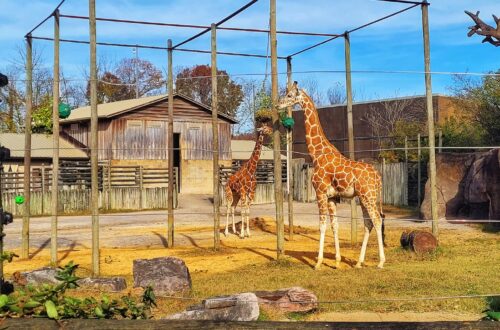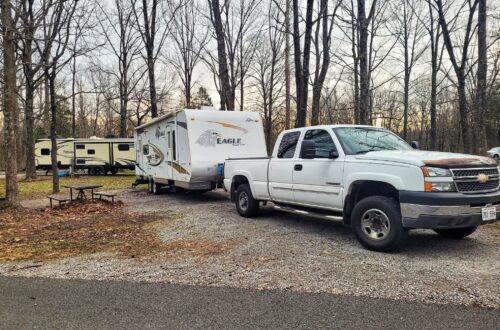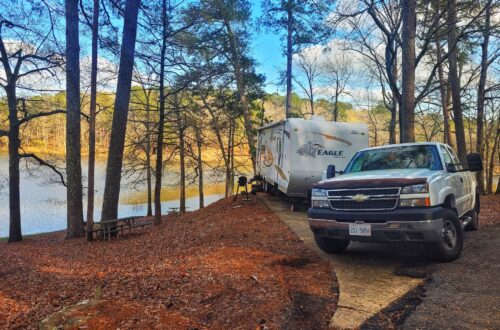Tucked away in the rolling hills of East Tennessee lies a place that feels like stepping back in time. The Museum of Appalachia isn’t your typical museum, it’s a living history village where the spirit of the Appalachian people lives on through handcrafted cabins, ancient tools, and stories etched into every corner. We visited this hidden gem on our travels and were completely captivated by its charm, authenticity, and the deep sense of connection it offers to a simpler, hardworking way of life. Whether you’re a history buff, a lover of folk art, or just someone looking to slow down and soak in a bit of American heritage, the Museum of Appalachia is a stop worth making.


How to Visit the Museum of Appalachia
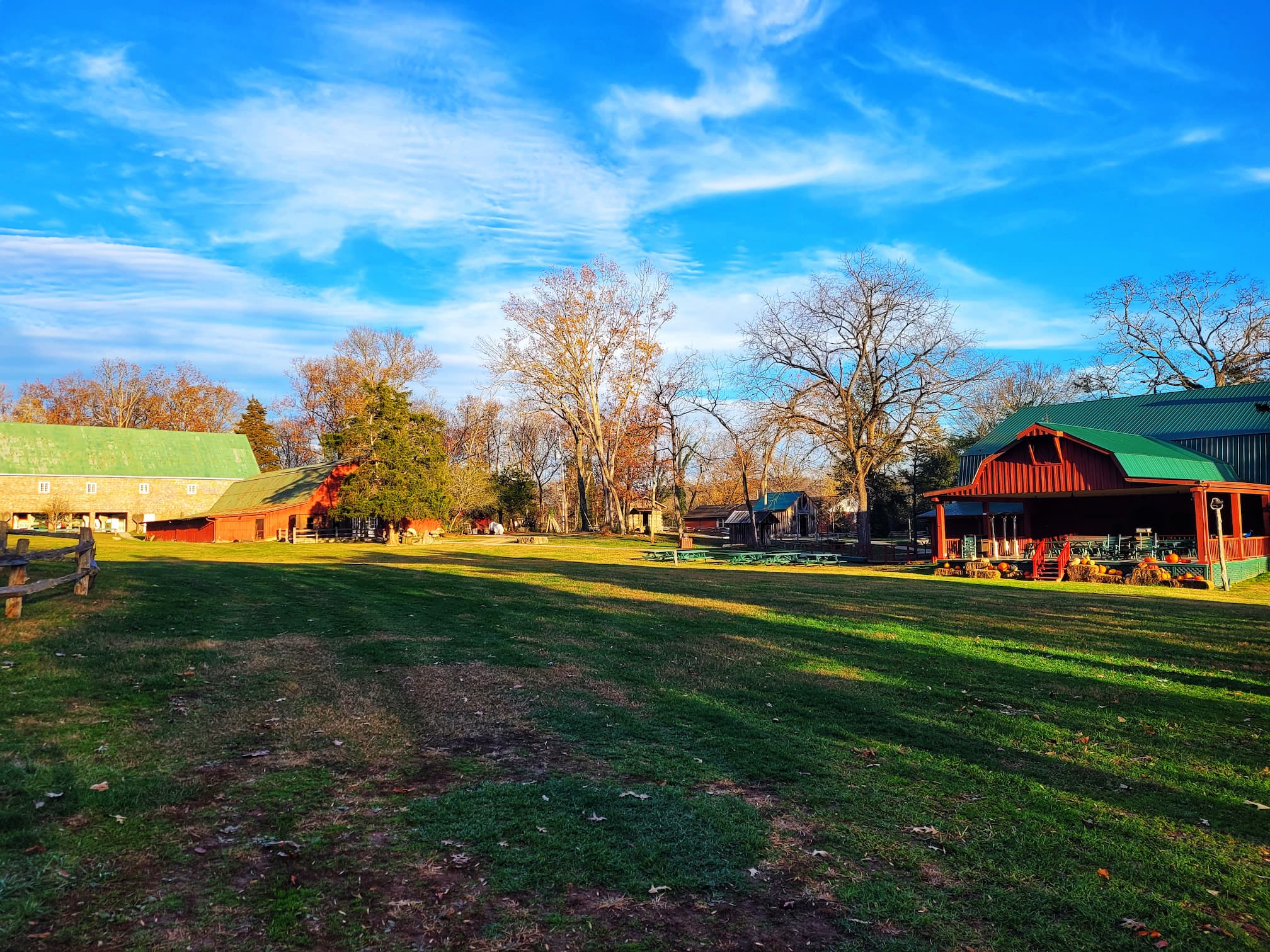
Address: 2819 Andersonville Hwy., Clinton, TN 37716
Website: https://www.museumofappalachia.org/
Hours:
- January: 10am-4pm
- February: 10am-5pm
- March-May: 9am-5pm Monday-Friday, 9am-6pm Saturday/Sunday
- June-September: 9am-6pm
- October: 9am-5pm Monday-Friday, 9am-6pm Saturday/Sunday
- November-December: 9am-5pm
Ticket Prices:
- Adults: $20
- Seniors (65+): $18
- Military & First Responders: $18
- Kids (6-17): $10
- Kids 6 & Under: Free
- Family Rate (2 adults, up to 6 kids aged 6-17): $50
Museum of Appalachia Gift Shop
The Shop at the Museum of Appalachia is open daily and full of locally made products. There are food products, homewares, gifts, and more sourced from local artisans. Upstairs there is also an area with antiques.
Museum of Appalachia Restaurant
The restaurant at the Museum of Appalachia serves lunch daily from 11am-2pm. They serve classic southern food. You do not need to purchase museum tickets to go to the gift shop or restaurant.
Appalachia Ridge Camping Experience
A new feature at the Museum of Appalachia is the Appalachia Ridge campground on the property. They offer full hook-up RV spots starting at $50/night, as well as glamping tents starting at $90/night. More info on camping at the Museum of Appalachia is available on https://appalachiaridge.com/
History of the Museum of Appalachia
The Museum of Appalachia got its start in 1969 thanks to John Rice Irwin, who spent decades crisscrossing the backroads of Southern Appalachia collecting everyday items and personal stories from the region’s mountain folk. What began as a personal project has grown into a nonprofit Smithsonian Affiliate, dedicated not just to preserving artifacts but to honoring the culture and history behind them. The museum’s mission goes beyond the physical collection- it’s about fostering a deeper appreciation for Appalachian heritage, both here at home and around the world.
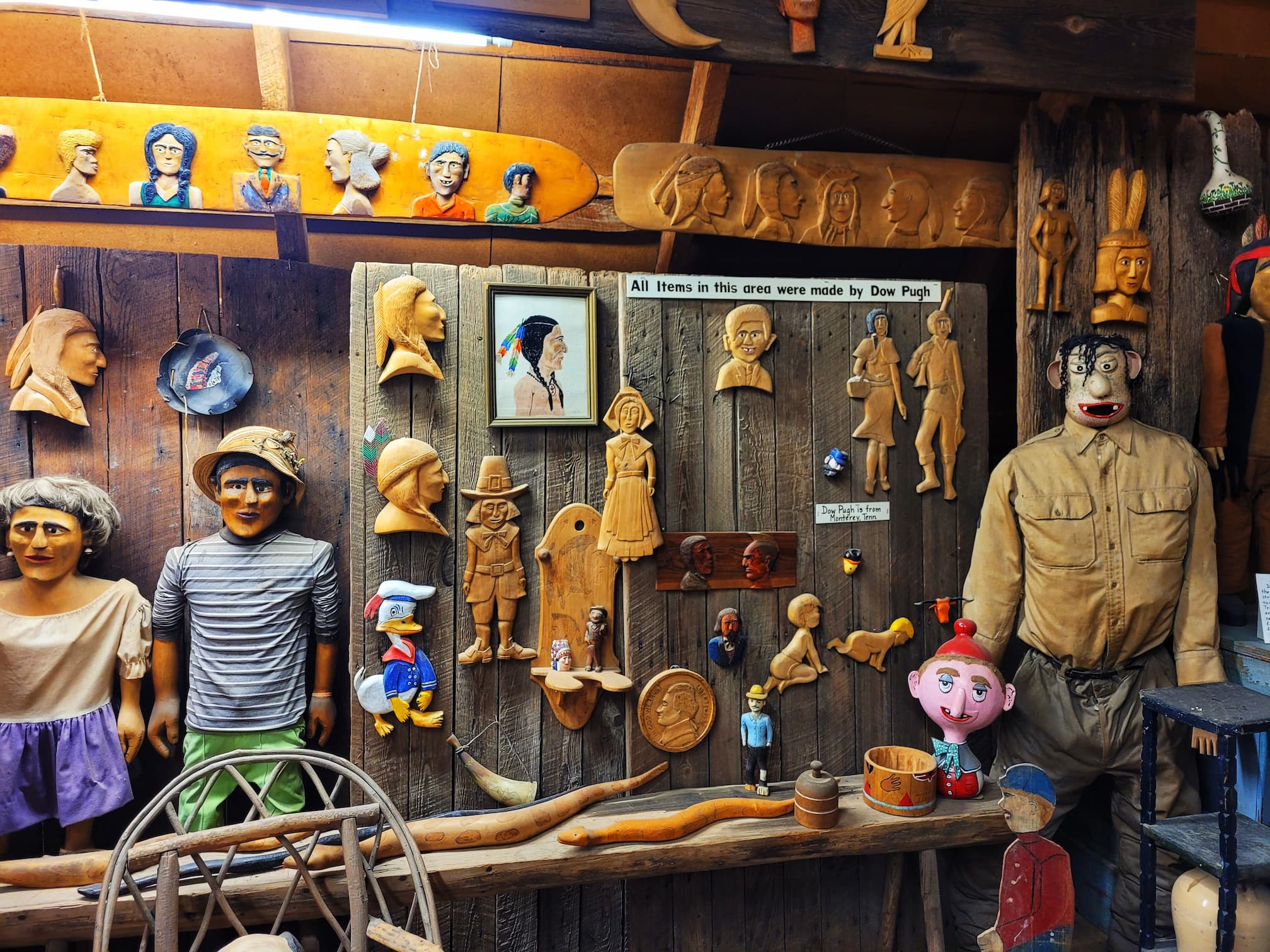

Let’s Explore the Museum of Appalachia!
The Museum of Appalachia consists of four main areas: The Village, The Display Barn, the People’s Building, and the Appalachia Hall of Fame. The Village is what they call their grounds and the 35 authentic log structures that have been moved to and reconstructed on the site. These are scattered around the grounds so you’ll be in and out of them between the other main buildings. The Museum is also a working farm, so there are peacocks roaming free and animals in pens beside the barns. It makes for a very peaceful and pastoral experience.
The Village

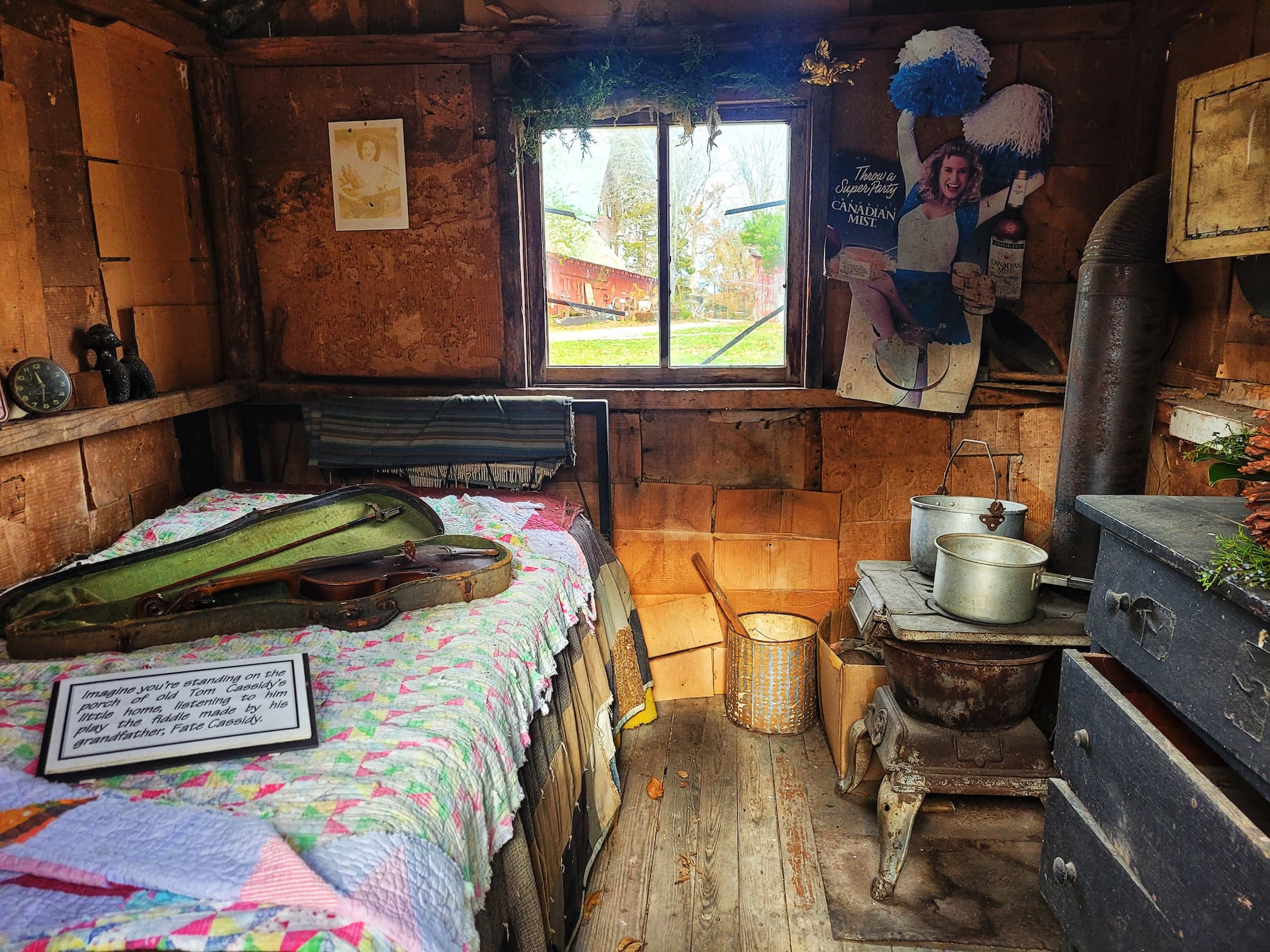
One of the first buildings we encountered (pictured above) is the Tom Cassidy House. Union County, TN native Tom Cassidy lived in this 8×8 foot cabin for most of his adult life. He’s quoted as saying, “I’ve got that little cot in there, a chair, a stove for heat and cooking, a frying pan, a bean pot, an old dresser, my fiddle, and my pistol; what more does a man need?” Living in an RV has definitely given us a new appreciation for small spaces and a simple life.
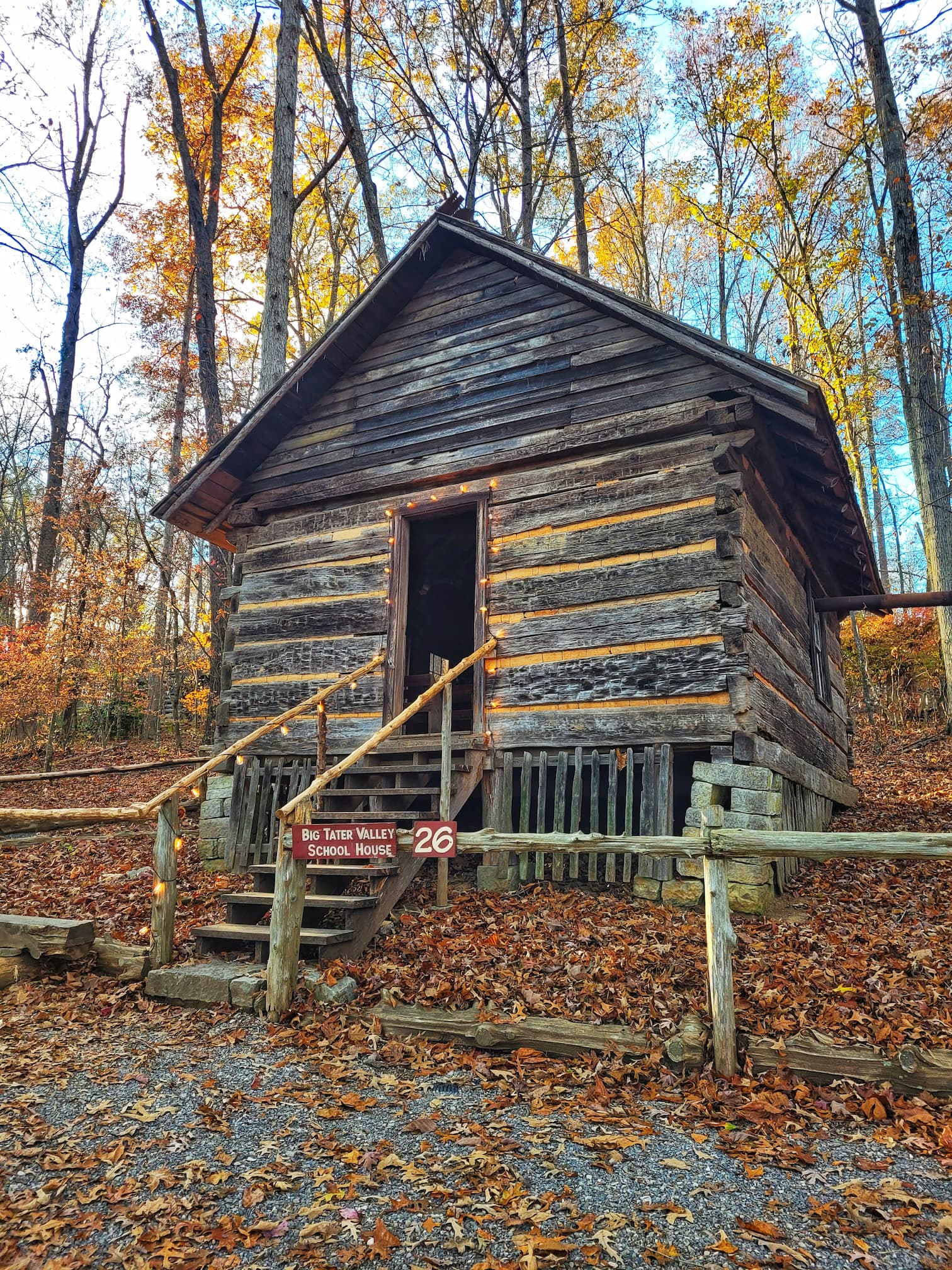
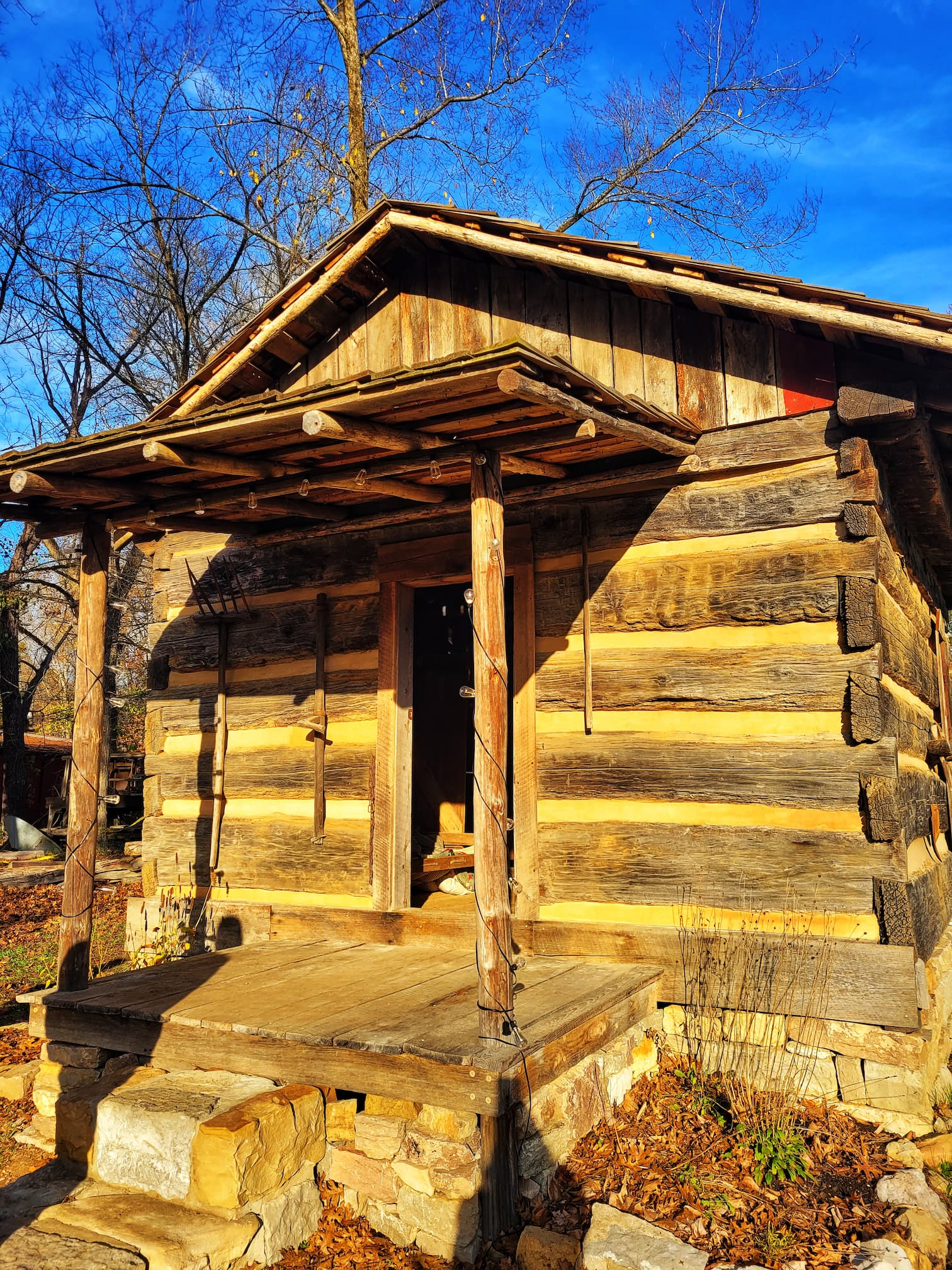
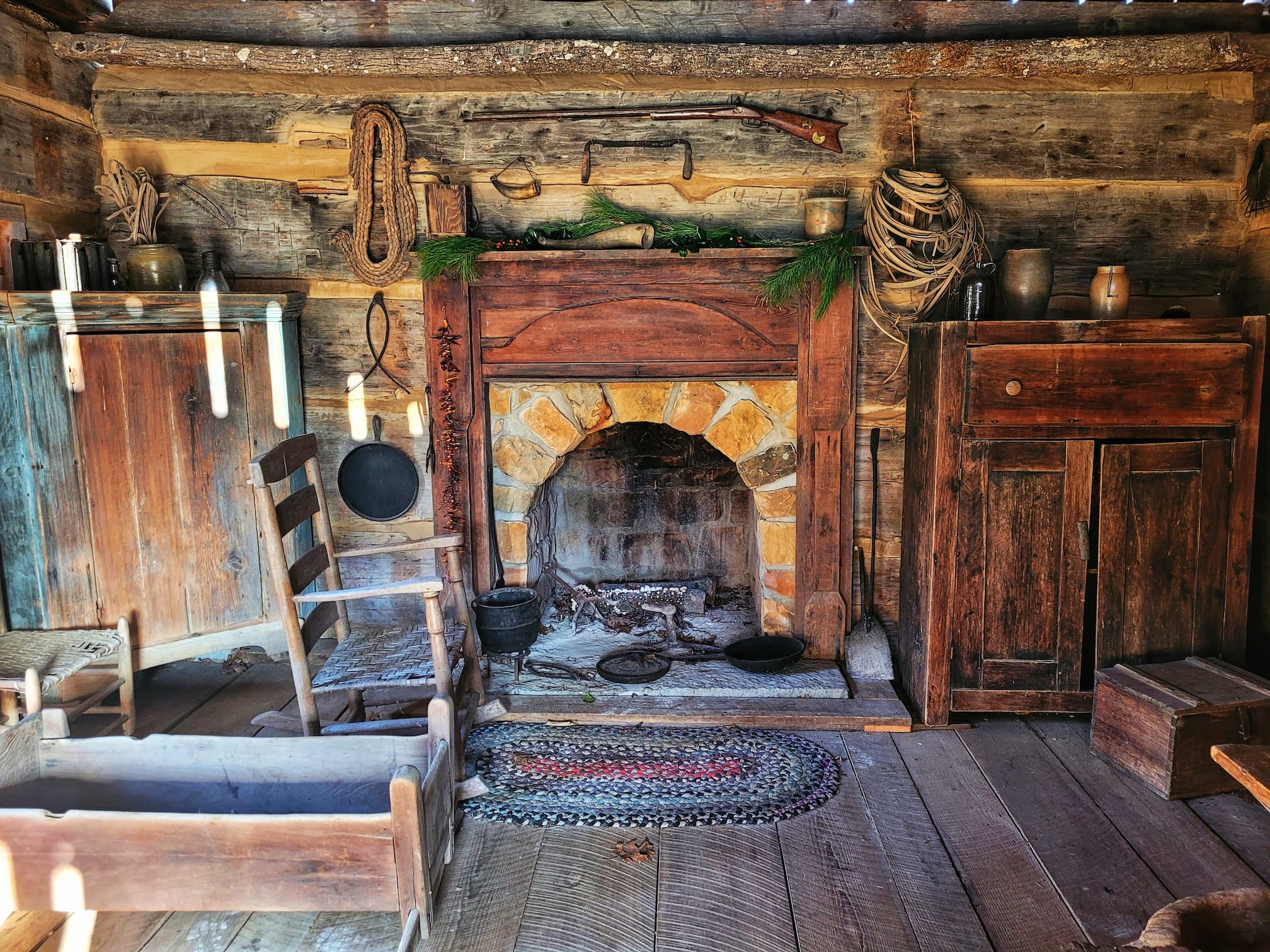
The first photo in the trio above is the Big Tater Valley School House. At Josh’s old job we were involved in a historic schoolhouse restoration project, so we sometimes feel like we can’t escape from one room schoolhouses. This one was moved from Big Tater Valley to the museum in 1974. It was built and founded in the early 1800s and was a functioning school for almost 100 years.
The second and third photo above are of the Arnwine Cabin. This log house was built by Wes Arnwine in the early 1800s. The building was first moved around 1930 when the Tennessee Valley Authority built the land it was on for constructing Norris Dam. Originally the family moved the cabin, and the family continued living in it. The last inhabitant, Eliza Jane Arnwine, died in 1936 and no one lived there until the museum acquired it in 1964. This building is on the National Register of Historic Places.
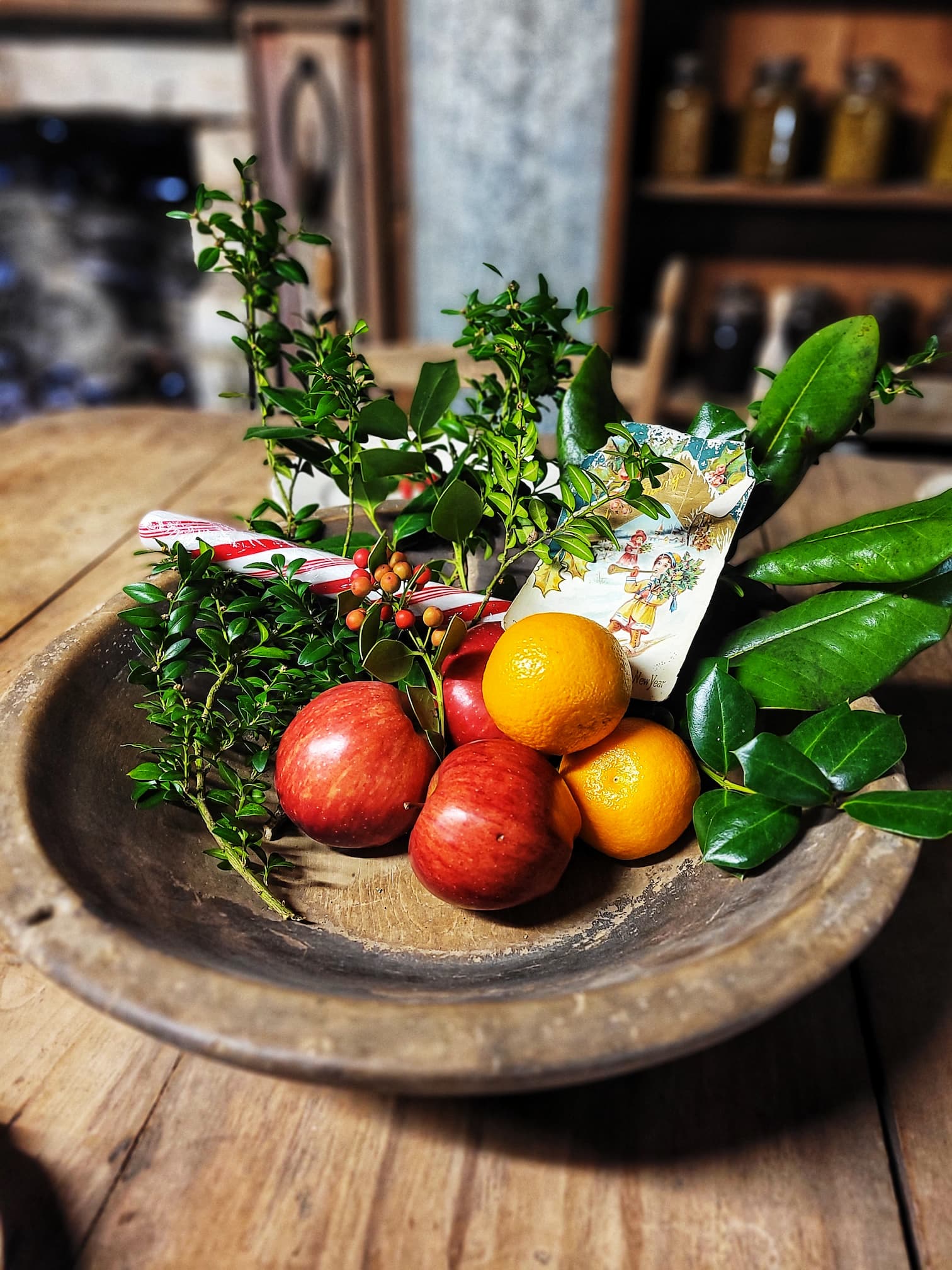

Most of the building at the Museum of Appalachia’s Village are open for you to go inside. There are a few closed for safety reasons (some of the barns and things like the blacksmith shop), but a lot of the home are open and furnished with period belongings. We visited the Museum of Appalachia in November, and they were in the midst of Christmas decorating. A bunch of the buildings were decked out with period appropriate decorations and it added so much to the charm of the place.
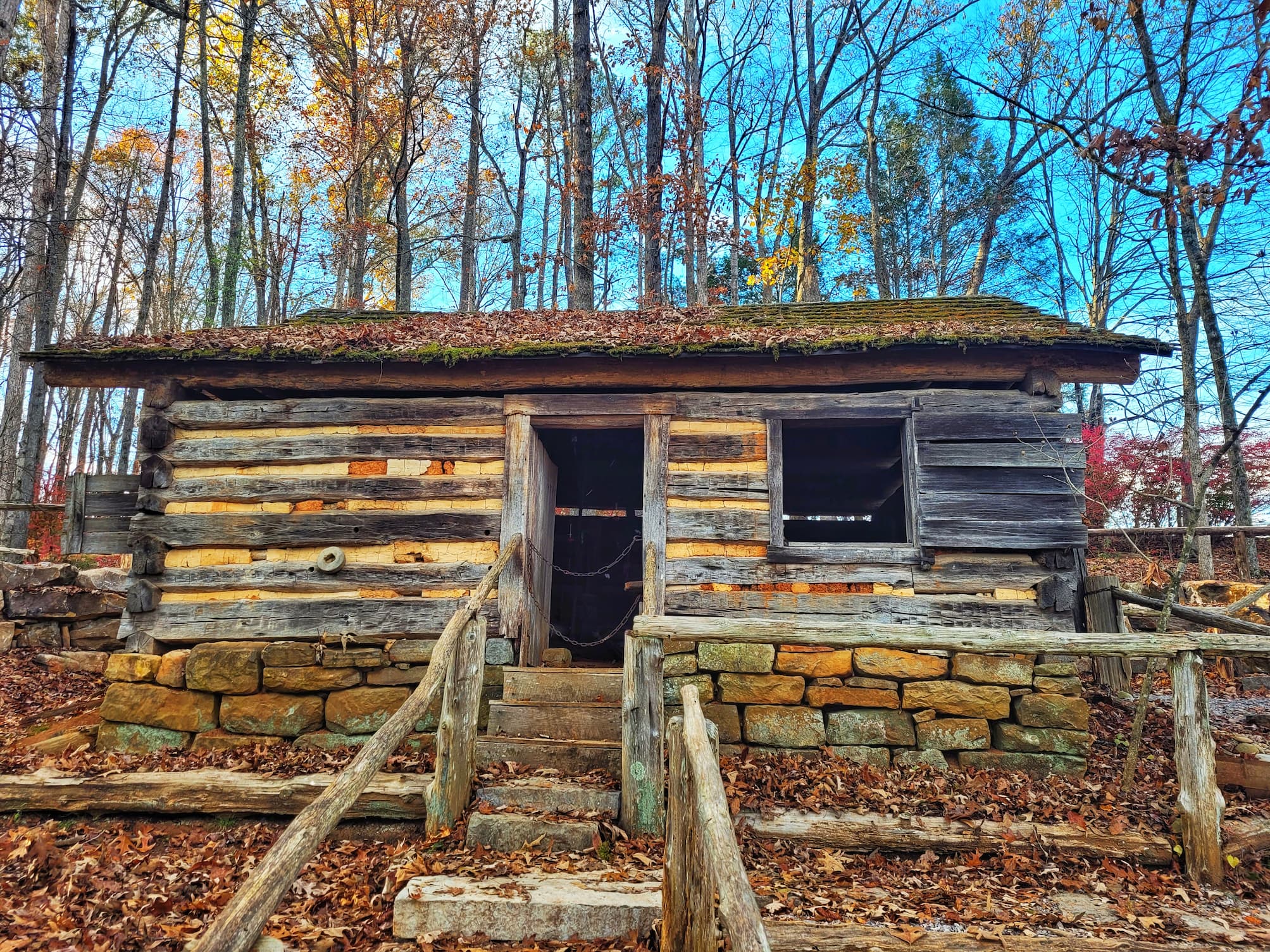
Above is one of the more famous buildings on the property- the Dan’l Boone Cabin. No, this wasn’t the home of the actual Daniel Boone, but it was home to the fictional one. This cabin was built in the early 1800s in Anderson County, Tennessee and then went on to be used by CBS for filming their TV show Young Dan’l Boone.

This next piece was probably Josh’s favorite. The whiskey still here belonged to the famous moonshiner Popcorn Sutton. Popcorn Sutton was born in 1946 in Appalachia and went on to become known for his moonshine and bootlegging. He wrote a popular guide to moonshining and eventually became the subject of several books, documentaries, and TV shows. Sutton’s fame didn’t make him immune to the law, though, and he ran into trouble with the authorities a few times. The last time, in a 2008-2009 case, he pled guilty to illegally distilling spirits and possession of a firearm as a felon. He was sentenced to an 18 month federal prison term, but Sutton took things into his own hands and killed himself by carbon monoxide poisoning instead. After his death, long-time Popcorn fan Hank Williams Jr. worked with Sutton’s widow to distill and distribute a whiskey named after Popcorn to continue his legacy. This still here was built on-site by Popcorn before his death.
Popcorn Sutton Media List:
- This Is The Last Dam Run of Likker I’ll Ever Make Documentary
- The Last One, with Popcorn Sutton TV Documentary
- Footage of Popcorn was used extensively in the TV Show Moonshiners
- Popcorn Sutton The Making and Marketing of a Hillbilly Hero Photobook
- Popcorn Sutton—A Hell of a Life Documentary
- The Moonshiner Popcorn Sutton Biography
The Museum of Appalachia Hall of Fame

The Museum of Appalachia Hall of Fame was unexpectedly our favorite part of the museum. I went in thinking it would be like any other hall of fame, but it was nothing like I expected. This wasn’t just portraits of famous Appalachians, it was a wide variety of exhibits about all aspects of Appalachian life. The founder of the museum, John Rice Irwin not only gathered hundreds of artifacts, but most of them also have hand-written signs where he tells the story of the everyday people they represent. The signs are quirky, funny, and sometimes poignant and we could have spent a whole day just in this one building.
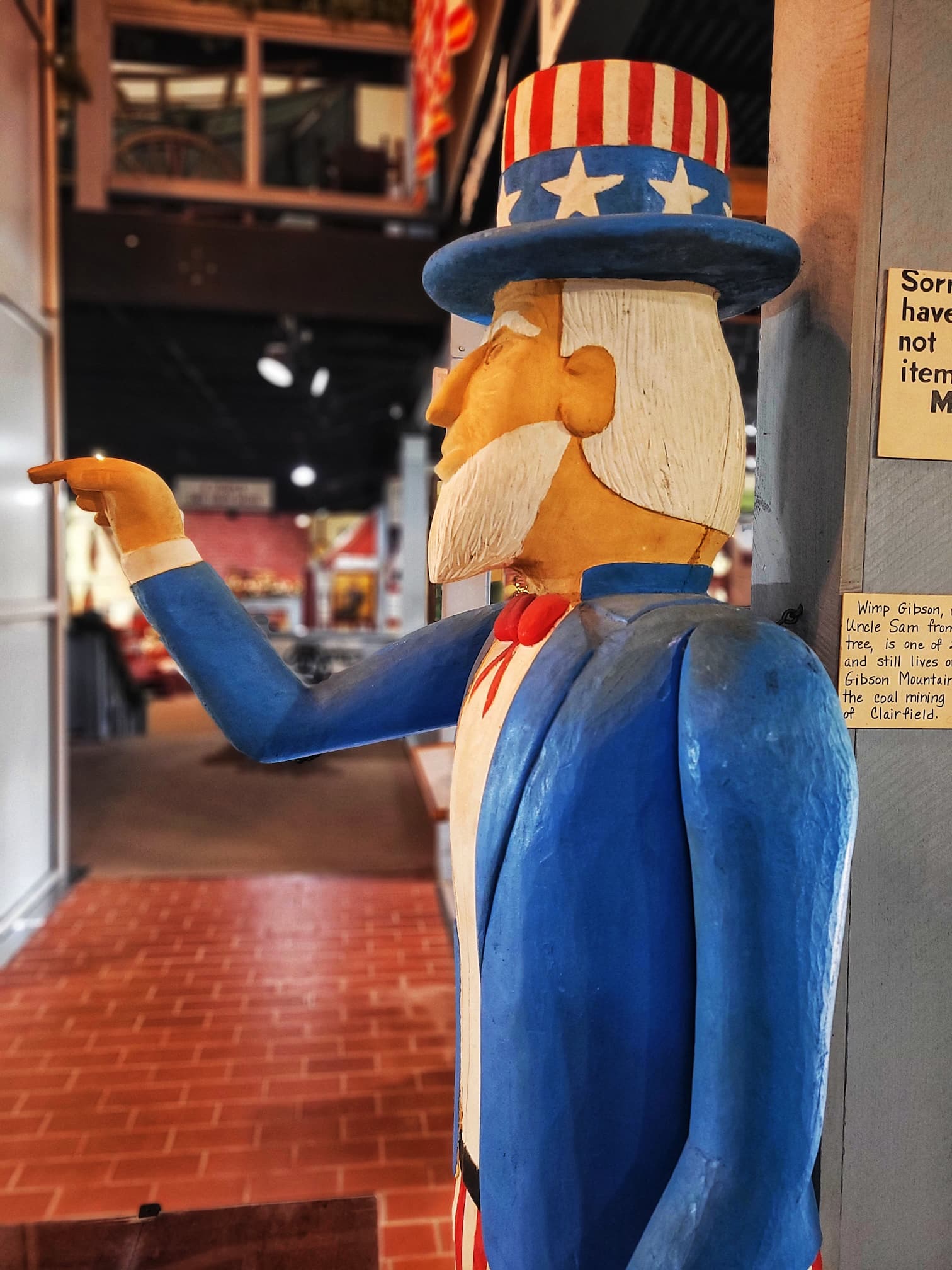
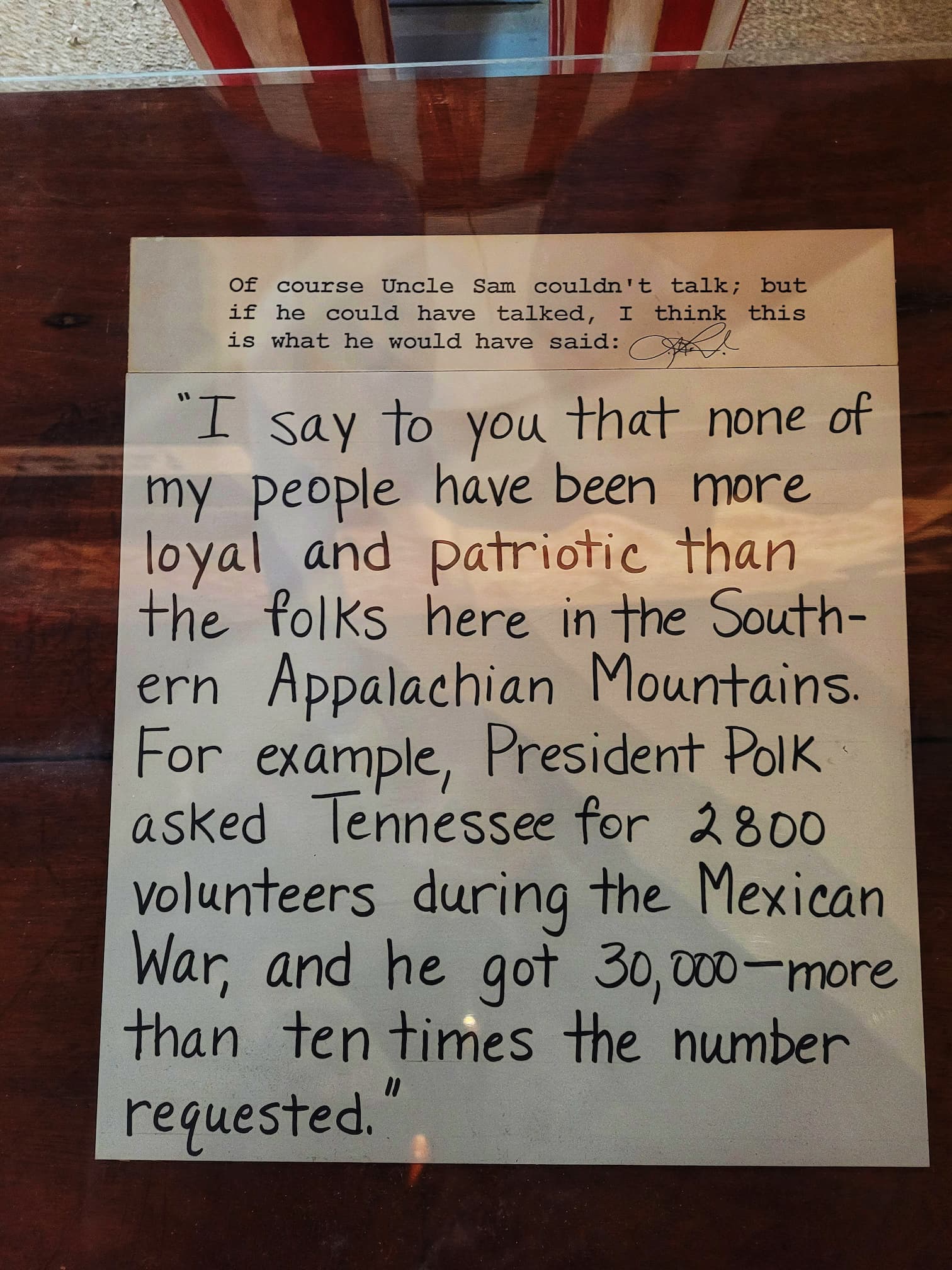
The sign here with Uncle Sam is just one of many examples of the hand-written signs throughout the Hall of Fame. They feel less like the typical museum sign trying to educate you, and more like someone telling their personal stories of their home and travels.
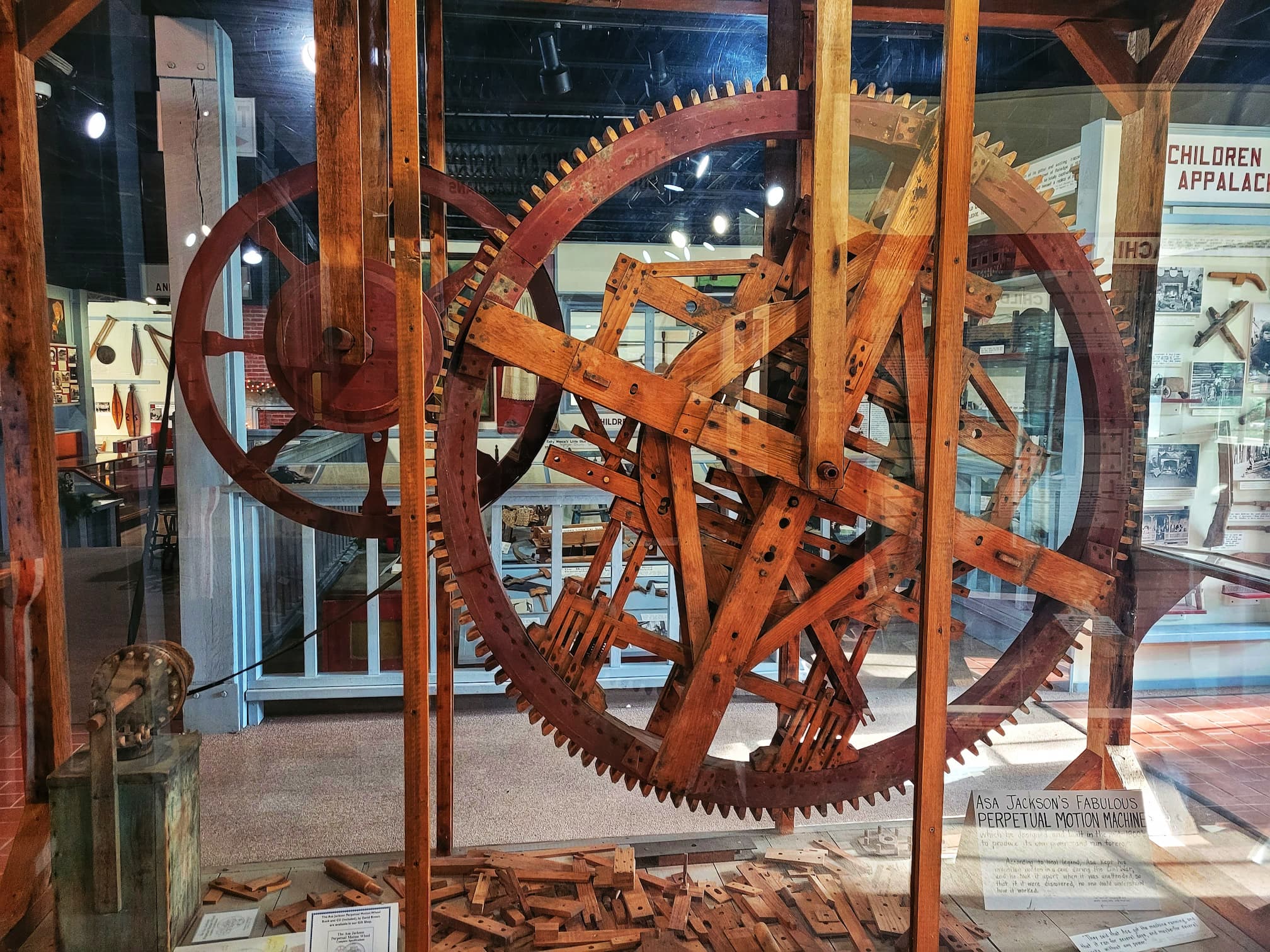

The photos above are of Asa Jackson’s Fabulous Perpetual Motion Machine. Asa built this machine in the mid 1800s and the idea was for it to produce its own power and run forever. The signs also say that legend has it that during the Civil War, he hid the machine in a cave and took it apart so that if anyone ever found it, they wouldn’t understand how it worked.
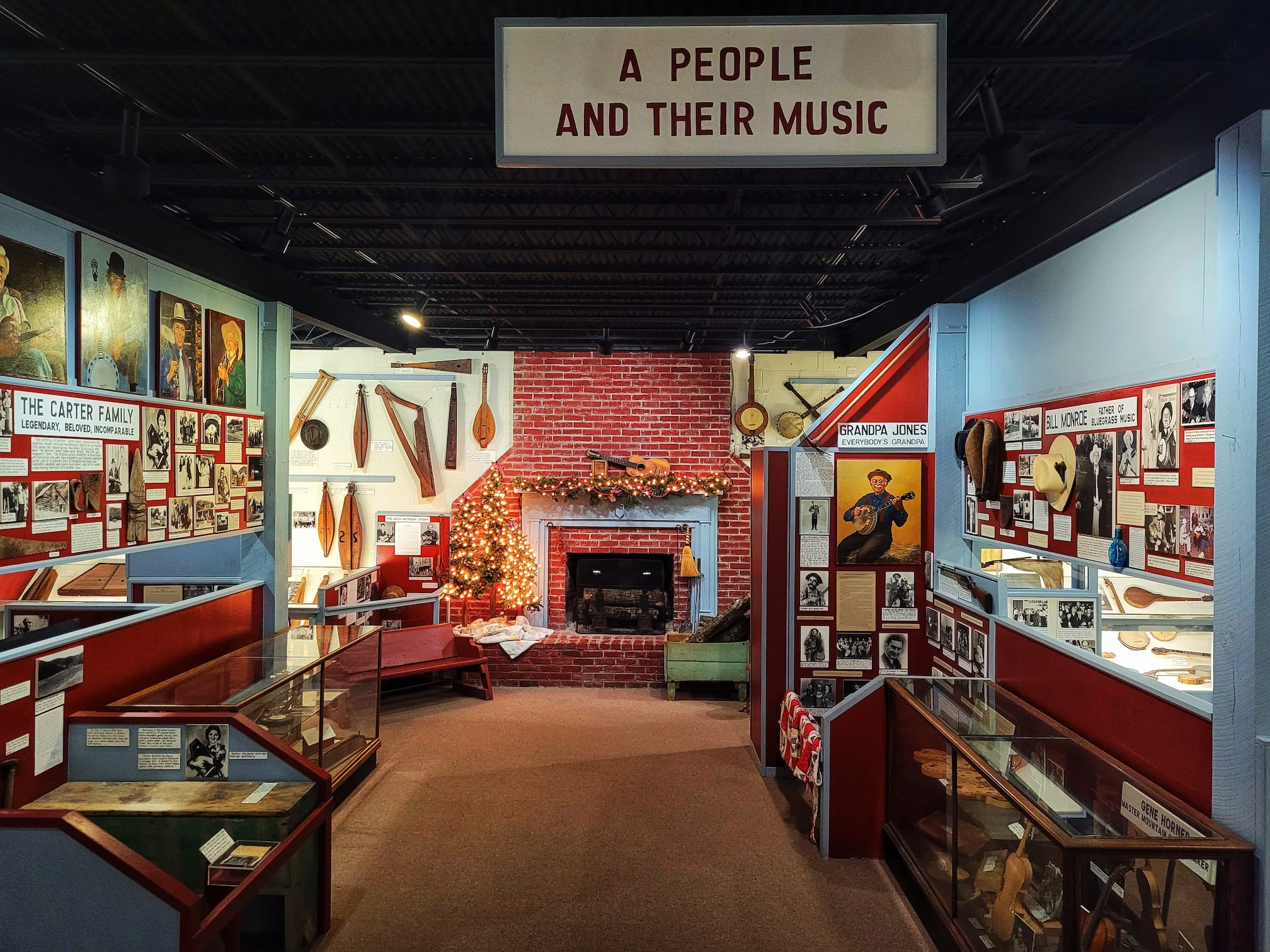


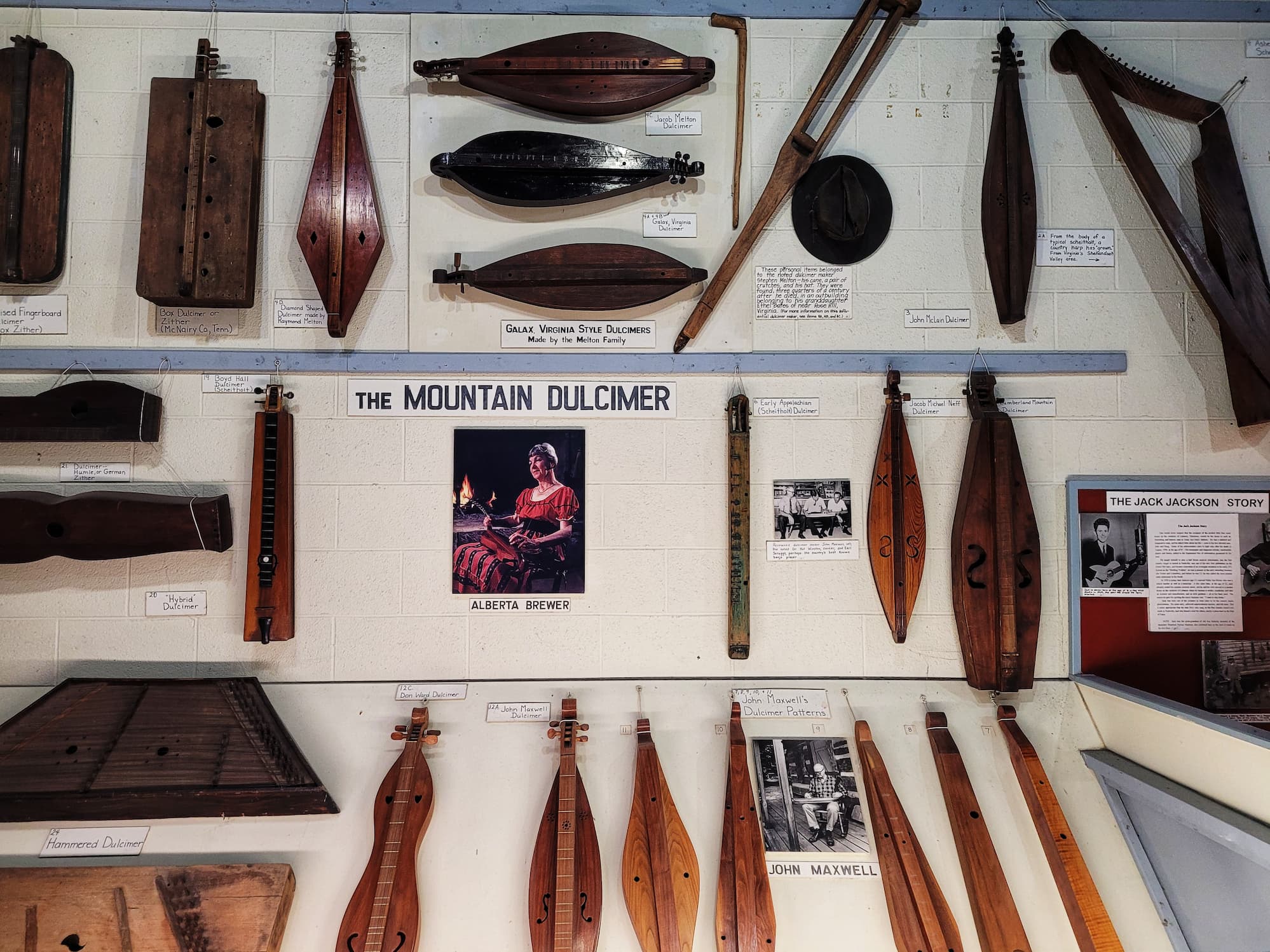
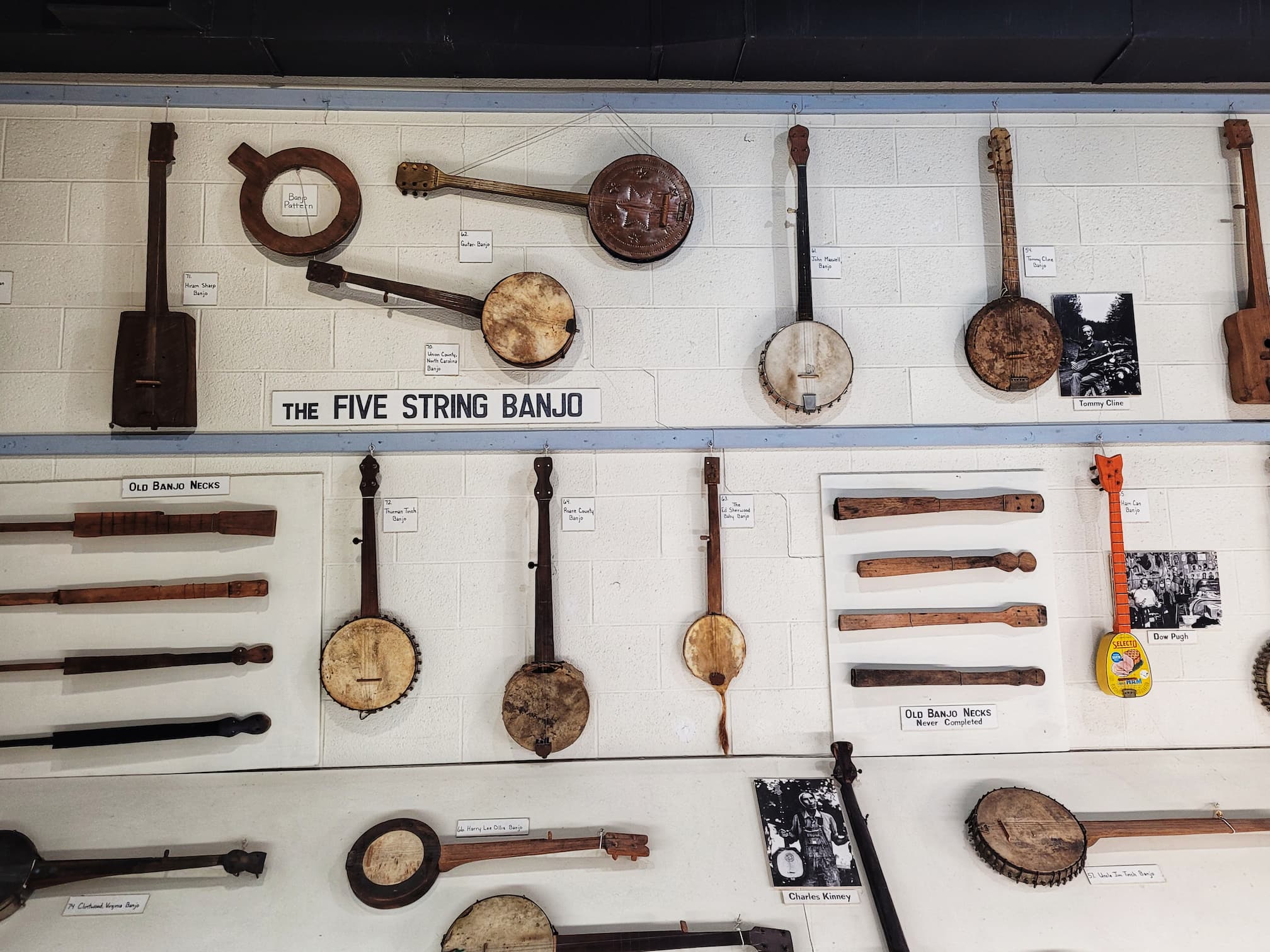
One of the larger exhibits in the Museum of Appalachia Hall of Fame is the section all about music. This area has some of the more traditional hall of fame type stuff- areas devoted to different famous Appalachian musicians, like the Carter Family seen above.
There are also walls covered in different instruments. I was in heave here! I play folk music, and I love handmade and unique instruments of all kinds. The photos above are just a small sample of the instruments on display here. I loved learning about the different types of each instrument, but my favorites are the handmade ones- look closely at the banjos and you can see one made from a ham can!
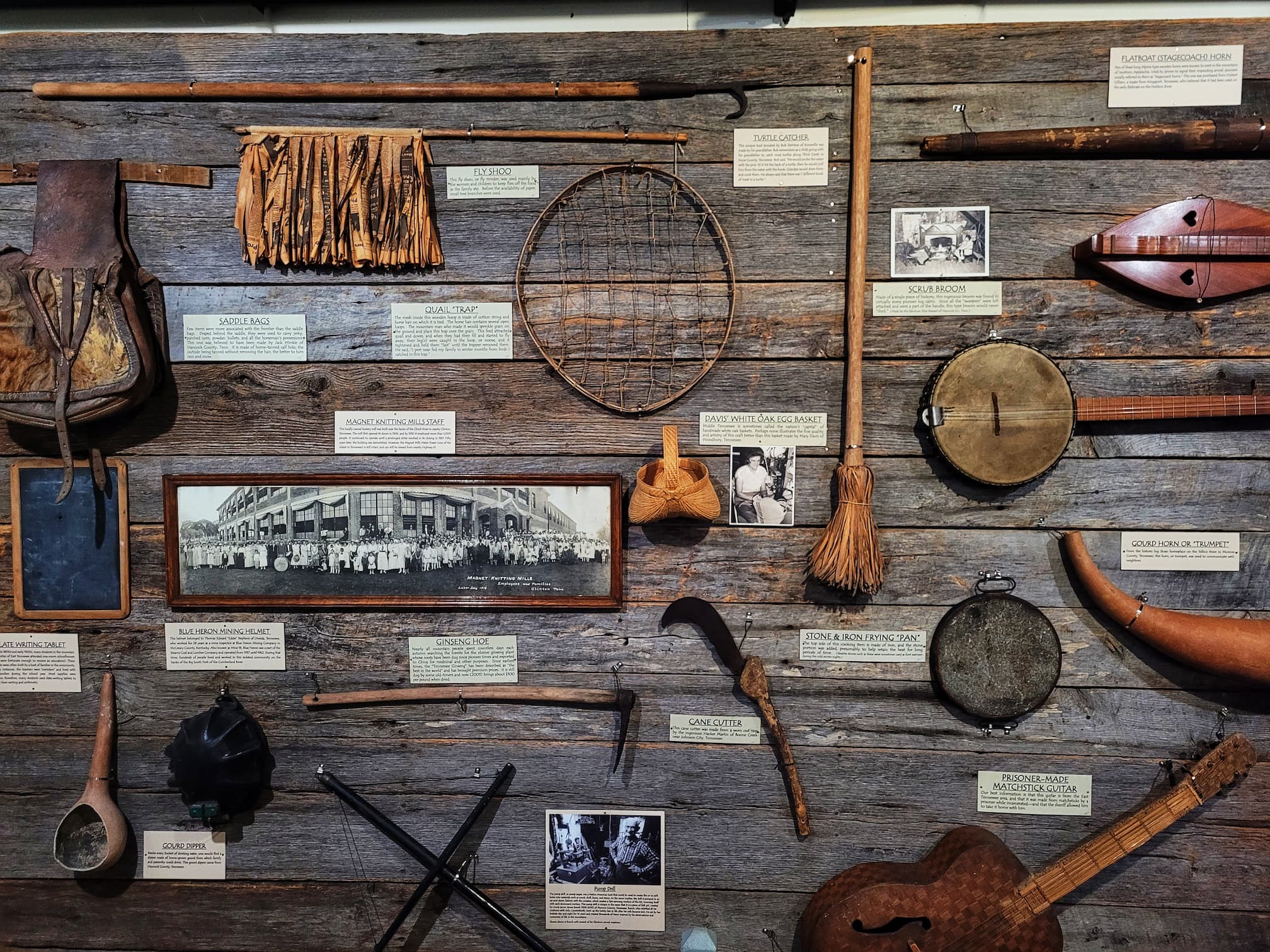
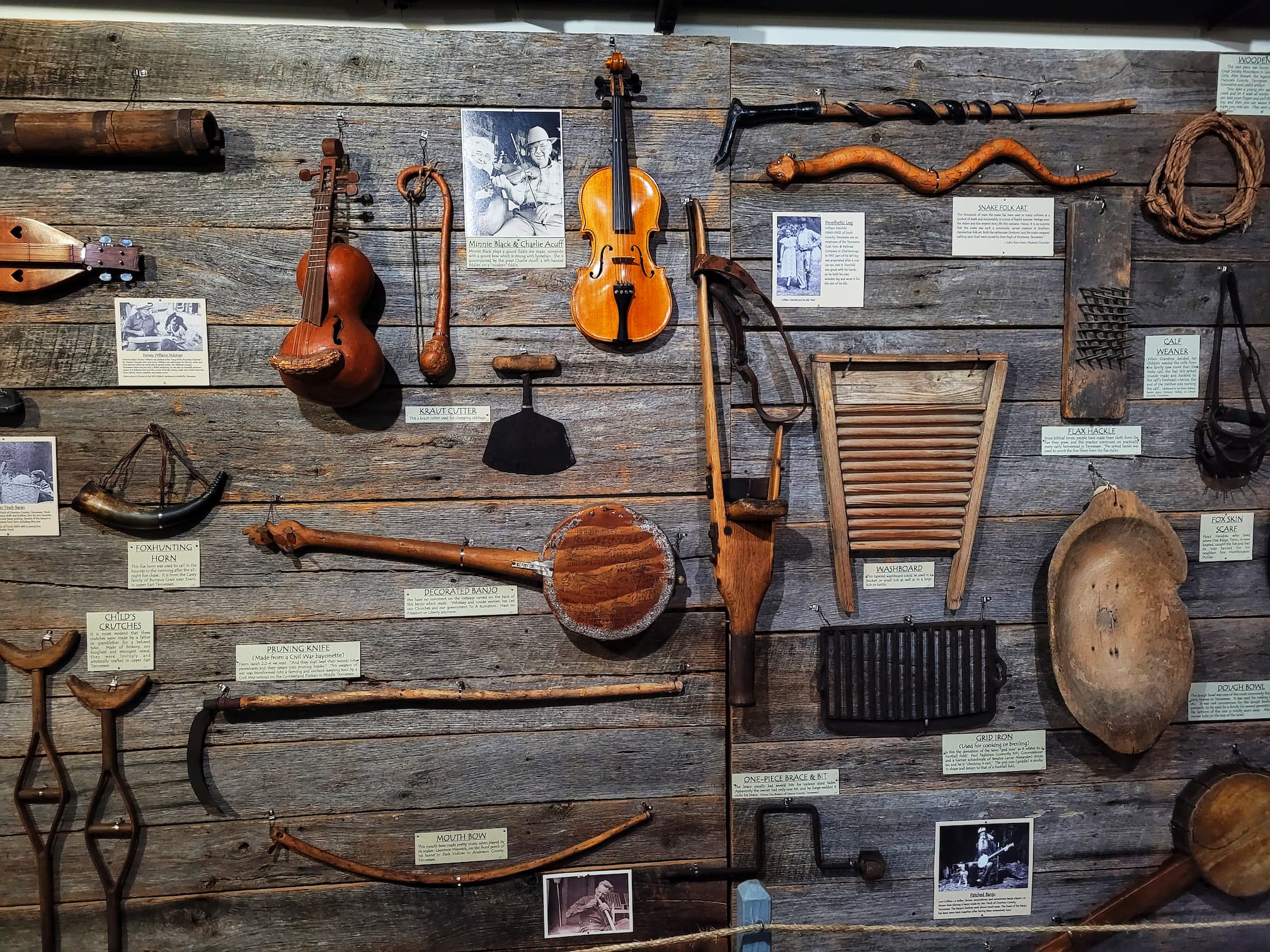
The two photos above are of another top favorite exhibit of mine in the Museum of Appalachia Hall of Fame. These aren’t just random museum artifact on the walls here, the walls themselves are an artifact. Tennessee Senator Lamar Alexander was elected in 2003 and was looking for a way to decorate his office in Washington DC. He wanted it to reflect the people he represented, so he gathered a committee of Tennesseans to help him. John Rice Irwin, founder of the Museum of Appalachia, was one of those Tennesseans. Irwin picked out artifacts from the museum’s collection that would give Senator Alexander’s visitors a sense of the history of their state. The office walls are said to have caused quite a stir in DC and got a lot of visitors. When Senator Alexander left office in 2021, some of his walls went to Tennessee Congressman Tim Burchett, and the others returned to the Museum. Josh actually almost walked right past this exhibit, thinking it was just a display of random artifacts, but one I showed him the sign explaining what it is, he agreed that it’s one of the coolest things here.
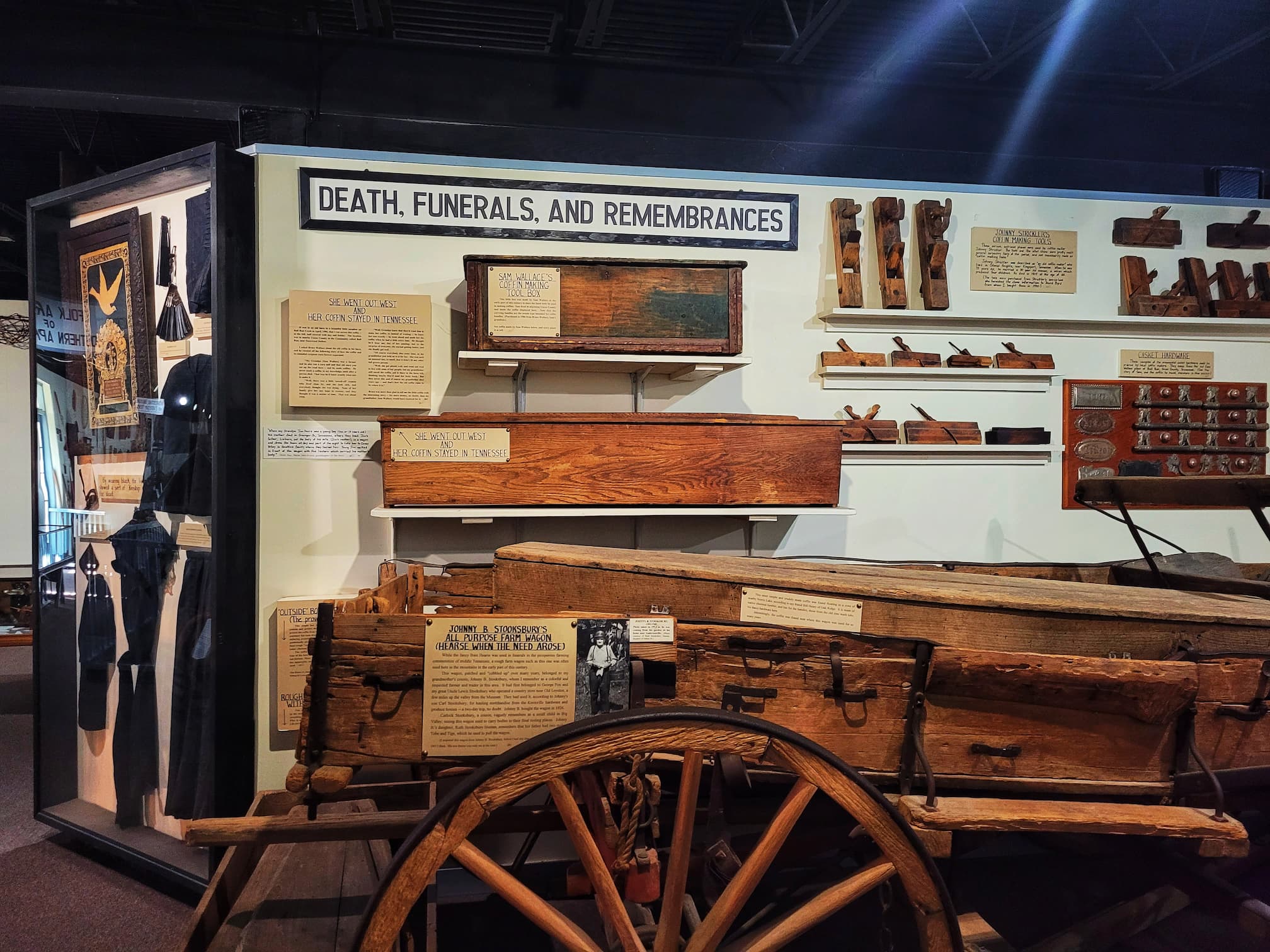
My love of all things spooky and sad is well-known, so I’d be remiss if I didn’t mention that there’s also a large exhibit dedicated to death, funerals, and remembrances. I took a lot of photos of this part of the Hall of Fame that I’m saving for its own post in October.
People’s Building
The main exhibit that’s outside of and inside the People’s Building is about Harrison H. Mayes. Mayes was a coal miner who survived a mining accident in 1918. After recovering from the accident, he thought he would be a preacher, but decided it wasn’t his calling after all. One day, though, he painted the words “Sin Not” on a hog and let it loose in the coal camp. Everyone in camp saw the message and he realized he had found his calling after all.


Mayes went on to paint signs on trees, rocks, barns, and more along roadsides to spread his message, while still continuing to work in the coal mine. Eventually he started making signs and eventually had signs in 44 states. Years later, the concrete signs seen below were rescued by the Museum when the Mayes home was being sold. These signs had never made it to their intended locations.
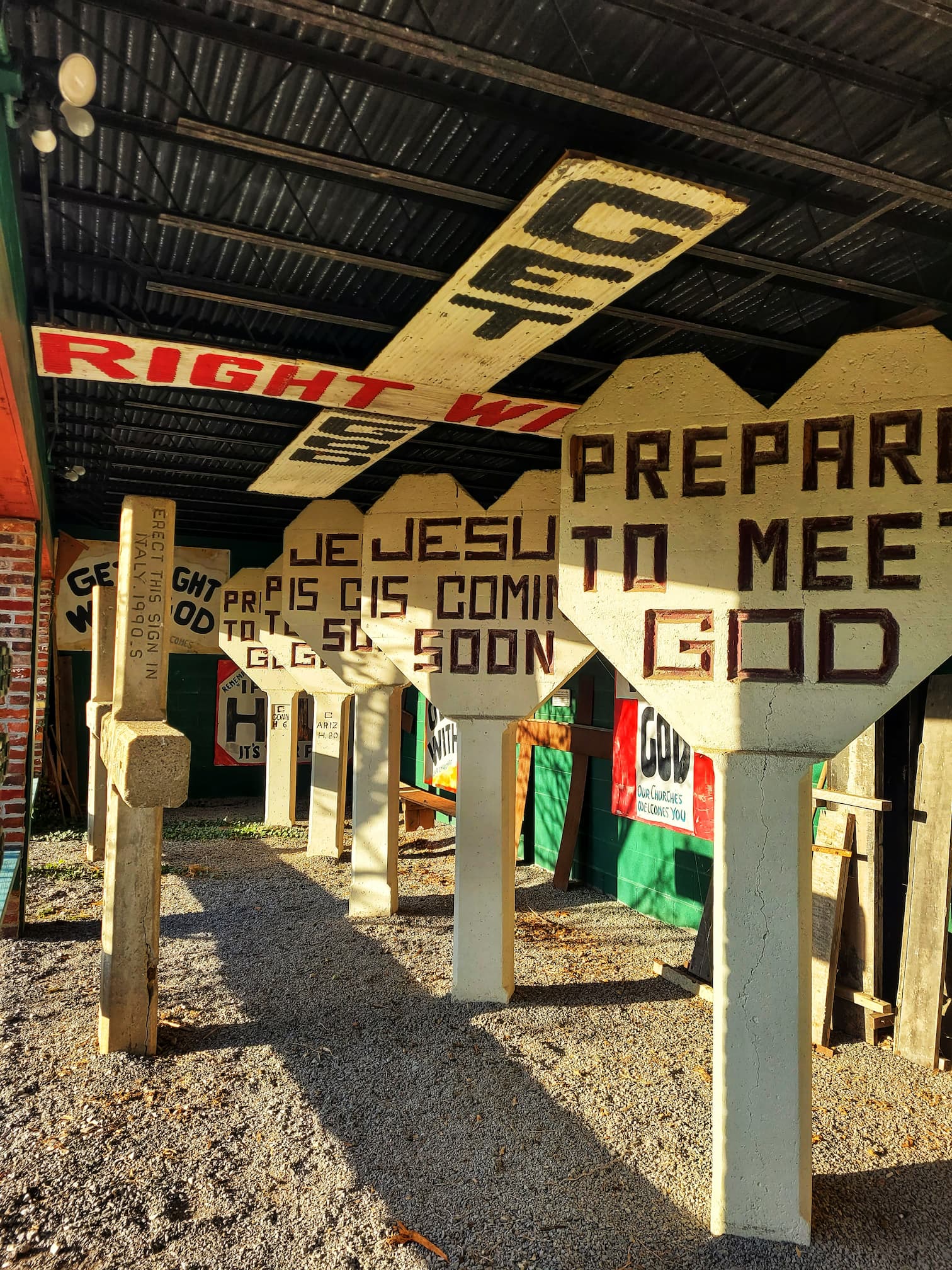
The Museum of Appalachia People’s Building has pieces from another CBS TV show. The period drama Christy aired from 1994-1995 and was about a young woman who taught at an Appalachian schoolhouse. The show was filmed nearby, and one episode was even filmed at the Museum.

The Display Barn
The second largest indoor space at the Museum of Appalachia is the Display Barn. This barn is packed with artifacts like industry and farming tools, and even a large collection of folk art.
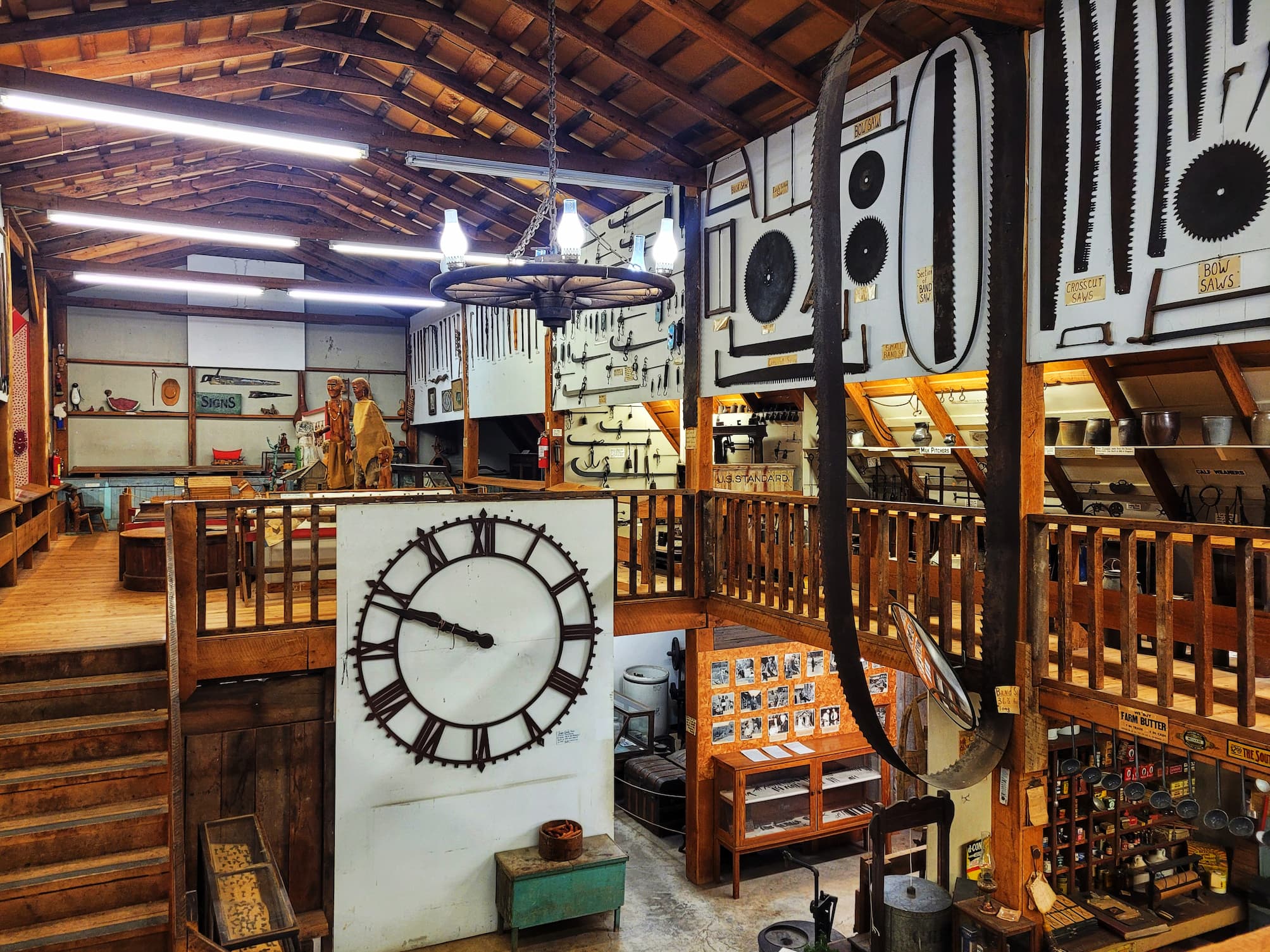

The Museum of Appalachia Display barn has not only a variety of displays, but each display has a variety of objects. The two photos above give you a sense of the barn. There are sections divided out not just by types of farming, but by types of tools- and each section has dozens of variations of the same tool or item. It’s a bit overwhelming, but really cool to see so many objects together like this.
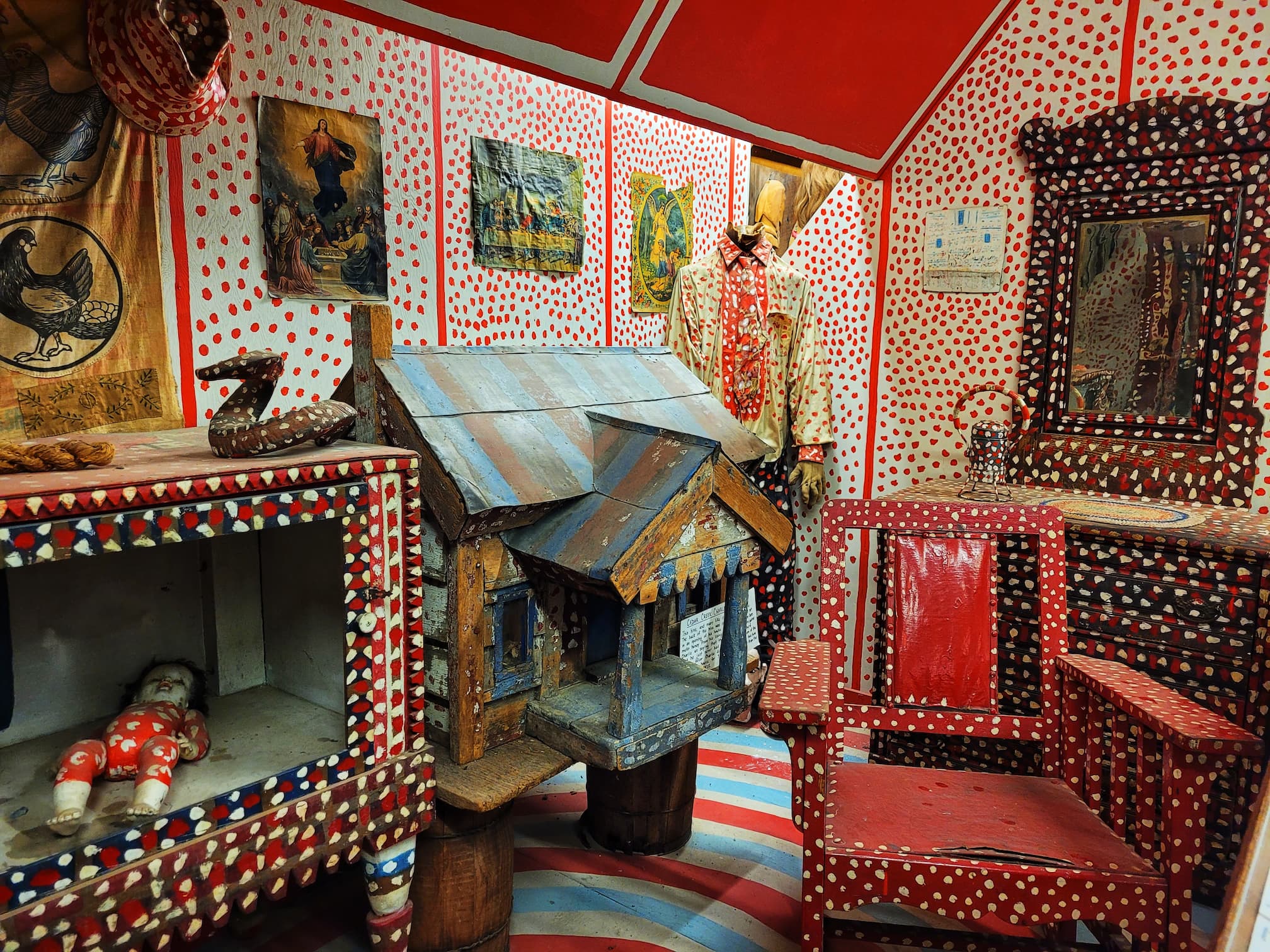
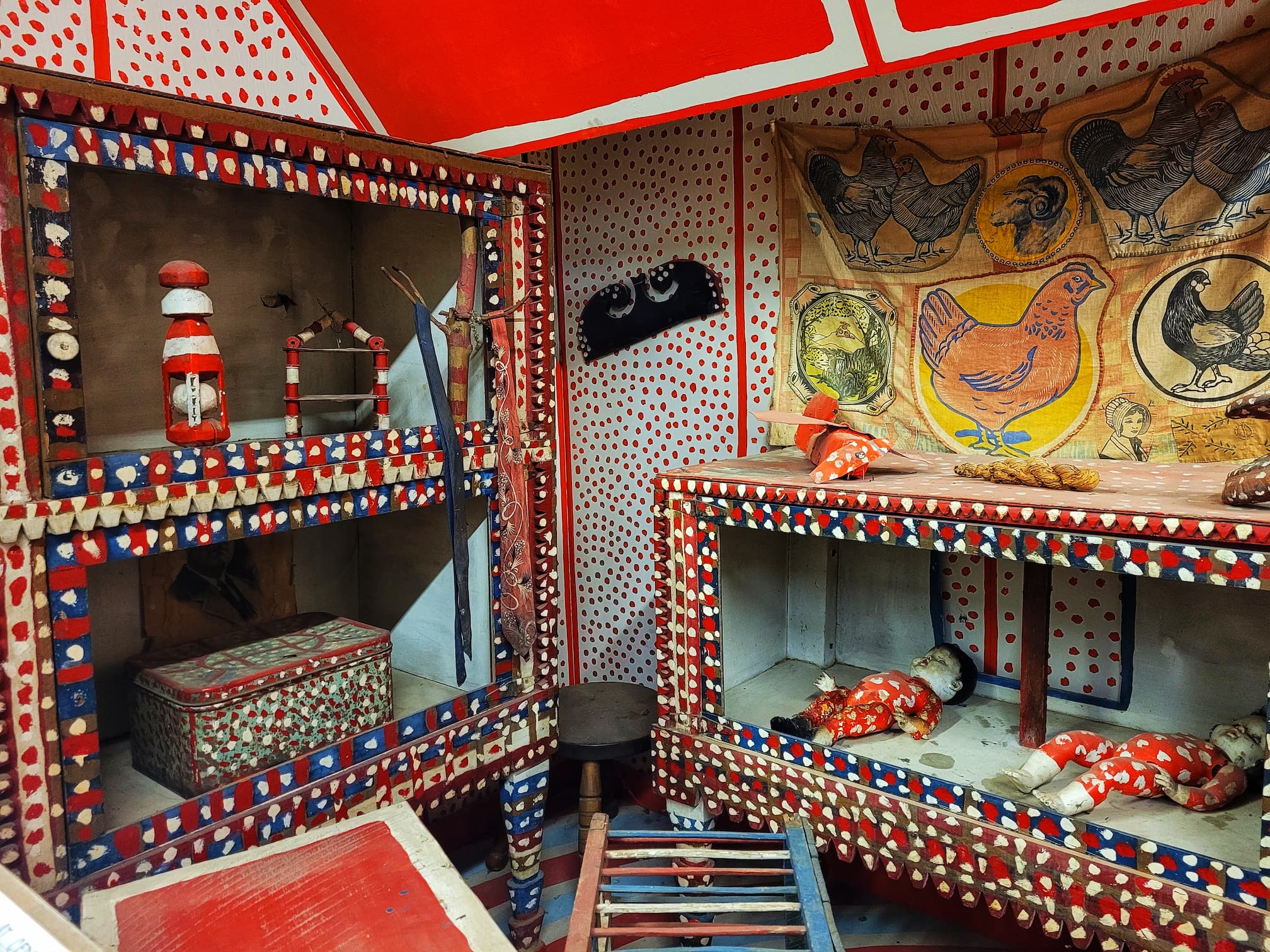
My personal favorite part of the Display Barn is the folk art, and specifically the art seen above. These polka dotted objects were painted by Cedar Creek Charlie. According to local accounts, Charlie never learned to read or write and took care of his mother after his father died. After his mom died, too, he started painting. He painted just about everything he could in red, white, and blue polka dots. The room on display in the museum is a replica of his bedroom that was put together with objects from his home after he died. I’m a big fan of outsider art and these pieces are just so cool, especially when put together like this. I am so obsessed with this exhibit!
Appalachian Film & TV Watchlist
If you’re craving more Appalachian vibes after your visit, these films and shows capture the grit, beauty, and heart of mountain life in all its forms. From haunting dramas to heartfelt stories, here’s a watchlist that brings the region’s spirit to the screen.
- October Sky: A gifted young man in a West Virginia coal town dreams of building rockets and escaping a life in the mines
- Harlan County, USA: A gripping documentary that follows a Kentucky coal miners’ strike, revealing the harsh realities of labor struggles in Appalachia
- Coal Miner’s Daughter: The inspiring true story of Loretta Lynn’s rise from poverty in rural Kentucky to country music stardom
- Where the Lilies Bloom: A resilient young girl in the North Carolina mountains fights to keep her family together after their father’s death
- The Wild and Wonderful Whites of West Virginia: A raw and chaotic documentary chronicling the notorious White family and their outlaw lifestyle in Boone Count
- Lawless: Three bootlegging brothers fight corrupt authorities and violent rivals during Prohibition in the hills of Virginia
- Justified: A modern Western crime drama following U.S. Marshal Raylan Givens as he dispenses justice in his troubled Kentucky hometown
- Next of Kin: A Chicago cop returns to his Appalachian roots to avenge his brother’s murder and confronts a deadly city-country feud
- Foxfire: A heartwarming tale of three generations of mountain women in Appalachia who reunite and rediscover the strength of family
- Out of the Furnace: A gritty drama about two working-class brothers in a struggling steel town, caught in a spiral of violence and desperation
- The Glass Castle: Based on a memoir, a woman reflects on her unconventional, poverty-stricken childhood in rural West Virginia and the resilience it gave her
- Reclaiming: A short film gathering oral histories of sexual and reproductive wellness traditions in Appalachian Ohio
- HEROIN(E): A powerful documentary following three women battling the opioid crisis in Huntington, West Virginia, one act of compassion at a time
- hillbilly: A personal and political exploration of Appalachian identity, challenging stereotypes and uncovering deeper truths about the region
- King Coal: A visually striking meditation on coal’s cultural legacy in Appalachia, blending memory, myth, and modernity
- The Mothman Prophecies: A chilling supernatural thriller rooted in West Virginia folklore, where strange sightings and eerie events hint at looming tragedy
- We Are Marshall: After a devastating plane crash, a small West Virginia town and its football team find hope and unity in rebuilding
- Holler: A coming-of-age story about a tough Appalachian girl who joins a dangerous metal scrapping crew to fund her dreams of college
- Appalshop Films: Grounded and community-driven documentaries and narratives that amplify authentic Appalachian voices and stories
- Songcatcher: A musicologist discovers and preserves traditional Appalachian folk songs while navigating the region’s cultural complexities
- Country Boys (PBS Frontline): A raw and intimate look at two teenage boys in rural Kentucky as they come of age amidst poverty, faith, and struggle
- Rocket City Rednecks: A fun and inventive reality show where Alabama scientists blend Southern ingenuity with high-tech experiments
- Matewan: A powerful dramatization of a 1920 coal miners’ strike in West Virginia, highlighting the fight for justice and union rights
As Amazon Associates, we earn on qualifying purchases.

